Australian-designed water filtration system maintains pristine Wetlands Exhibit Waterco’s award-winning Multicyclone also saves time, money and energy
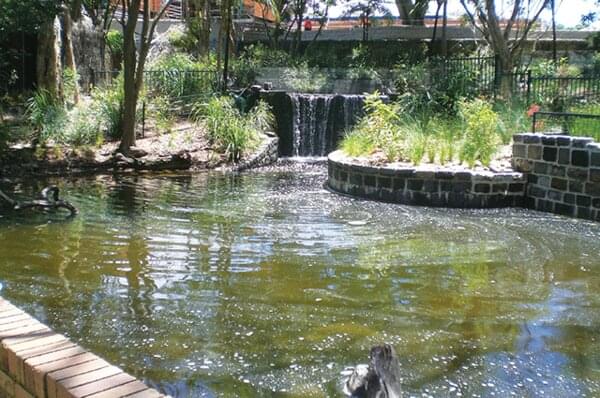
- Taronga Zoo’s Wetlands Exhibit holds over 450,000 litres of water in its ponds
- Ten manifold Waterco MultiCyclones focus on collecting finer particles, where the flow rate through each ranges between 200-300-litres per minute
- The MultiCyclones have since maintained superior water standards expected by Taronga Zoo’s elite team of keepers
Challenge
Keepers of the Sydney-based Taronga Zoo’s Wetlands Exhibit – which holds over 450,000 litres of water in its ponds – were finding it hard to maintain water quality due to the mess and matter left behind by birds flying in from surrounding areas.
Because there was no particular water filtration process applied to the Wetlands Exhibit, zookeepers were forced to manually empty the ponds on a regular basis. Not only did this result in a significant amount of water loss but also caused unnecessary disturbance to the various bird species.
“The Wetlands Exhibit was relying on natural filtration, and because birds from the surrounding areas were attracted to it, it was causing significant problems,” says Waterco sales representative Stefan Begbie.
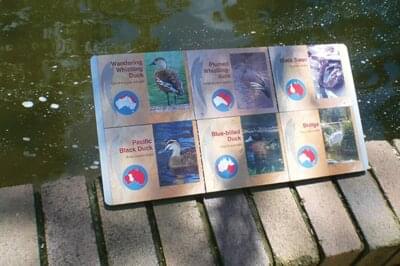
Taronga Zoo’s Wetlands Exhibit holds
over 450,000 litres of water in its ponds.
“Taronga Zoo wanted an environmentally-safe, efficient and cost effective way to save valuable water, plus a low impact strategy for filtering the Wetlands ponds. As the Waterco solutions had previously been used in the Wollomi exhibition (Platypus enclosure), our clients were keen to set up a similar filtration solution.”
Solution
Capable of saving water and reducing filter maintenance, the award-winning MultiCyclone works on the basis of centrifugal filtration. With no moving parts to wear and tear, and no filter media to clean or replace, it was the perfect solution for this aquatic habitat.
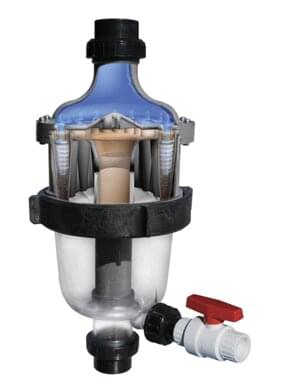
Capable of saving water and reducing
filter maintenance, the award-winning
MultiCyclone works on the basis of
centrifugal filtration.
To solve the various problems, a customised Waterco MultiCyclone skid was assembled offsite and craned into Taronga Zoo in a safe area away from the public eye. This sophisticated system consisted of four key components:
- Ten MultiCyclone 16 pre-filters
- One Flygt submersible pump
- Two Waterco Hydro 5000 160-litre commercial strainers
- One custom-made skid with an automatic solenoid valve for backwashing with 200mm pressure pipe
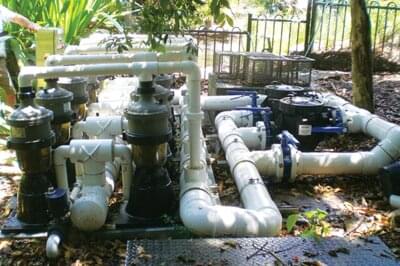
Acustomised Waterco MultiCyclone
skid was assembled offsite and
craned into Taronga Zoo.
The pump is capable of producing 45-litres per second at 15/20 metres head, while the MultiCyclone filters out debris from as little as 50-litres per minute through to and in excess of 400-litres per minute. Due to the pump’s unique flow curve, calculations showed that when plumbed as a manifold, both skid and MultiCyclone have since maintained superior water standards expected by Taronga Zoo’s elite team of keepers.
Fuss-free filtration
The filtration cycle starts in the pond where water runs through customised 8mm mesh baskets that catch large sticks and debris. Water then passes through the pump, which has a 220mm impellor, four-pole motor, 100mm inlet/outlet, and is operational at 1445rpm. Once large debris has been captured, water then flows through two manifold Waterco Hydro5000 commercial strainers, which each feature a 150mm inlet/outlet and 16-litre strainer baskets.
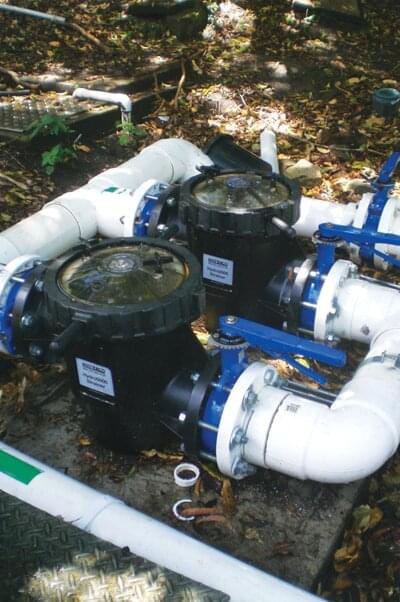
Two manifold Waterco Hydro5000
commercial strainers, which each
feature a 150mm inlet/outlet and
16-litre strainer baskets.
Ten manifold MultiCyclones focus on collecting the finer particles, where the flow rate through each ranges between 200-300-litres per minute, depending on the upkeep of the strainer baskets and filtration system.
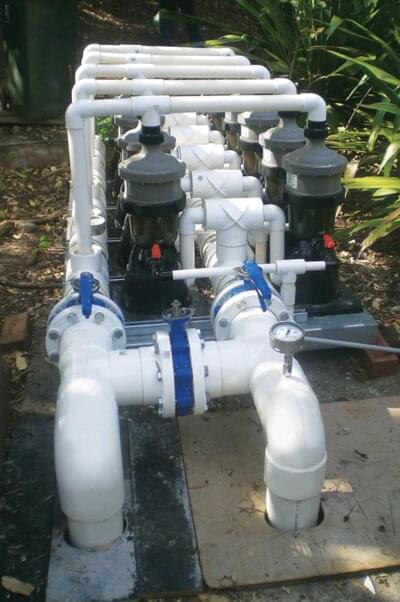
Ten manifold MultiCyclones focus on
collecting the finer particles, where
the flow rate through each ranges
between 200-300-litres per minute
The skid has been custom fitted with an automatic solenoid that can be programmed to open and close for the system’s back flush requirements.
Filtered water then travels 15-20-metres to pond number one, flowing down waterfalls that naturally aerate and filter the water prior to it reaches ponds two, three and four.
Benefits
This sophisticated, water saving filtration process automatically runs 24/7, leaving zookeepers to focus their attention on tending to the birds and animals that reside in the popular Wetlands Exhibit.
A sustainable alliance
As part of its mission to achieve sustainable outcomes and reduce environmental impacts, Taronga Zoo will be working with Waterco on the proposed renovation of the popular reptile enclosure in 2011.
About Taronga Zoo
After the first public zoo in New South Wales (NSW) outgrew its Moore Park location, the state government granted 43 acres of land on the northern shore of Sydney’s majestic harbour to the Zoological Society of NSW. On October 7th 1916, Sydney’s Taronga Zoo was officially opened with exhibits that included seal ponds, an elephant temple, monkey pits, top entrance, aviaries, paths and roadways, and the refreshment rooms.
In all, 228 mammals, 552 birds and 64 reptiles were moved from Moore Park to Taronga. Many, including the elephants, crossed the harbour on board a flat top barge. After a critical review in 1967, a new era in the style and philosophy for the operation of Taronga began, which reflected the new emphasis on scientific research, conservation and education. Today, the Taronga Conservation Society is renowned worldwide for its programs involving endangered species, wildlife health and habitat restoration, and education.